March 10, 1927
Bellflower

Police received a tip that next to the home of Ray Foss in Bellflower, several people had been observed burying something that may have been the body of an infant. Thankfully, no bodies would be found. Police had discovered however, that Ray had an outstanding felony warrant from 1925 for operating a "baby farm" in Moneta (near Gardena). The fear of being nailed on the baby farm charge loosened his tongue, and Ray Foss began to relate a sordid tale of baby trafficking, illegal adoption, an alimony racket, bigamy, and narcotics addiction.
Ray told the cops that a woman being held in County Jail on forgery charges under the name of Minnie Williams was actually his wife, and that she had been the proprietress of the Moneta baby farm.
The baby farm had come to the attention of the authorities in 1925 when Minnie sold a baby girl to a woman who gave her name as Mrs. Johnson. The infant was found to be blind, and Mrs. Johnson returned the child and demanded a refund. The child later died. Mrs. Foss gave the woman $25 in cash, and in lieu of the remaining $35, she gave her another baby! Ray and Minnie fled a short time later to avoid standing trial.
During the next two years Minnie trafficked in babies, ran an alimony racket, and fed her drug addiction. She provided infants for women to carry into court when seeking alimony. Prior to being identified as Minnie Foss, she’d tried a variation of the alimony con in Judge Hardy’s court. Using the Williams alias, she made an emotional plea for probation on the forgery charge, alleging that she was about to become a mother. The court soon discovered that she was not actually Minnie Williams, and that she was wanted in the Moneta baby farm case. With the masquerade over, Mrs. Foss began to confess to Deputy District Attorney Costello.
Things got off to a strange start when Minnie was asked to state her name for the record. She told the Deputy DA that her last name was really Hines, not Foss. She said that she’d married Ray Foss when she was only 15 years old, and then met Clarence Hines in 1921. The three lived together in a ménage a trois until Foss left. Minnie claimed that she then married Clarence, but never went to the trouble or expense of divorcing Ray.
How did Minnie end up trafficking in babies? According to her, she was in fact, a "serial adopter". In 1922 she had noticed a newspaper ad about adopting a baby. She said that she went to the Mexican quarter near the Plaza and met with a couple who told her that they had a child they couldn’t keep. Minnie took the baby home and passed him off to Clarence as his own child. She told him that the child had been born to her while she was away in Burbank!
Clarence may have been a very dim bulb, because over the next few years Minnie said that she brought home several other infants including a set of twins, and that she had informed him that he was the father! According to Minnie, Clarence never questioned her about any of the babies, so she continued to adopt.
Maybe Clarence wasn’t quite as gullible as Minnie had thought, however. When questioned by police, Clarence told a slightly different story. He said that he’d known that his wife sometimes placed “not wanted†babies. He also told investigators that he was aware of a black trunk which may have been used to store baby clothes or as a coffin for some of the unwanted babies. The trunk was later found at a home near Bakersfield that had once been occupied by Ray Foss.
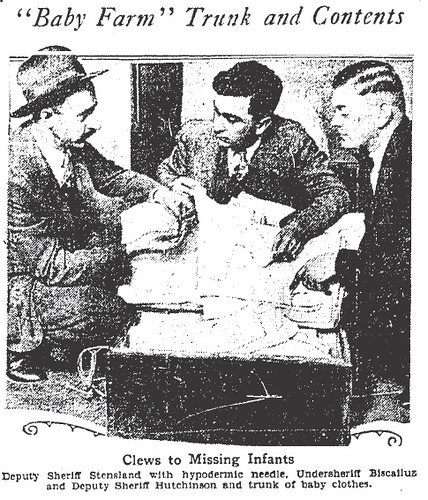
When the trunk was examined by police it was found to contain baby clothes, a hypodermic needle, and a marriage license issued to Ray Foss and Minnie Magnolia Williams. Also found in the trunk were approximately twenty-four photographs of young girls and babies.
Even though Minnie said that she’d adopted the infants, the most likely scenario was that she occasionally kept unwanted babies born to women in her care. Where did all of the babies go? Police traced many of the children to foster parents who subsequently adopted them. Several infants remained unaccounted for.
Although there were many unanswered questions – particularly regarding the fates of the infants who could not be found, Deputy DA Costello dropped the baby farm charges because Minnie and Clarence had confessed everything to his satisfaction – including an addiction to narcotics for which Minnie was treated with Narcosan. The DA’s office couldn’t pursue the bigamy charges because the statute of limitations had run out.
Minnie pleaded guilty to issuing a fraudulent check and was given a sentence of from one to fourteen years in prison. Clarence received a similar sentence.


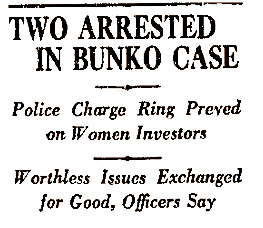 It’s a pretty simple scheme.
It’s a pretty simple scheme. 

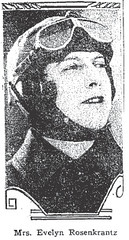
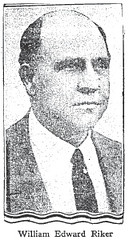 William and his followers returned to California and set up his “New Jerusalem” near Los Gatos. Surprisingly, he never got around to building a church in Holy City, but he did manage to construct a gas station (which sold “holy water” for over heated autos), restaurant, and an observatory where visitors could view the moon for ten cents. Located on the Santa Cruz Highway, Holy City became a tourist destination and was eventually bringing in over $100,000 ($1.2 million 2007 USD) annually. Tourists were lured by signs with such catchy slogans as: "See us if you are contemplating marriage, suicide or crime!" and "Holy City answers all questions and solves all problems!"
William and his followers returned to California and set up his “New Jerusalem” near Los Gatos. Surprisingly, he never got around to building a church in Holy City, but he did manage to construct a gas station (which sold “holy water” for over heated autos), restaurant, and an observatory where visitors could view the moon for ten cents. Located on the Santa Cruz Highway, Holy City became a tourist destination and was eventually bringing in over $100,000 ($1.2 million 2007 USD) annually. Tourists were lured by signs with such catchy slogans as: "See us if you are contemplating marriage, suicide or crime!" and "Holy City answers all questions and solves all problems!" 

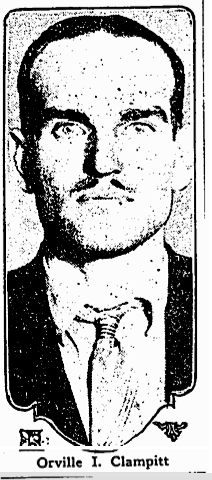
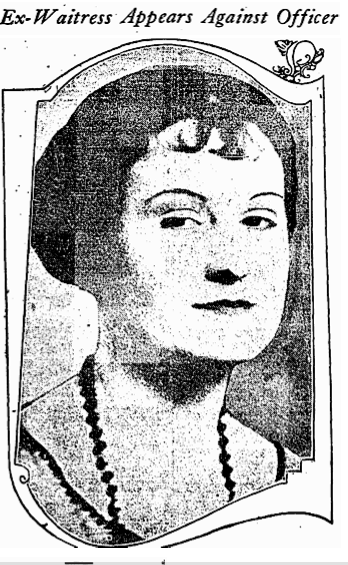

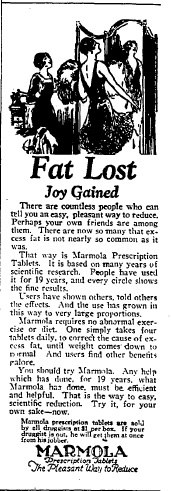
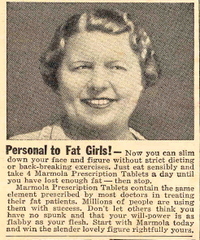 A young woman from Chicago came forward with a horror story that left courtroom watchers in tears. She told the judge that she had purchased Marmola because she was tired of her weight being the subject of cruel taunts by her classmates. Her excess pounds began to melt away, but she had also developed some nasty side effects. She hadn’t known that she was taking desiccated thyroid in toxic amounts. By the end of seven months she was vomiting regularly and her weight would eventually plummet to a cadaverous 50 pounds! At the time of the trial she was deathly ill with persistent symptoms of
A young woman from Chicago came forward with a horror story that left courtroom watchers in tears. She told the judge that she had purchased Marmola because she was tired of her weight being the subject of cruel taunts by her classmates. Her excess pounds began to melt away, but she had also developed some nasty side effects. She hadn’t known that she was taking desiccated thyroid in toxic amounts. By the end of seven months she was vomiting regularly and her weight would eventually plummet to a cadaverous 50 pounds! At the time of the trial she was deathly ill with persistent symptoms of 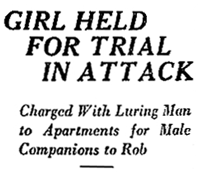

 August 19, 1927
August 19, 1927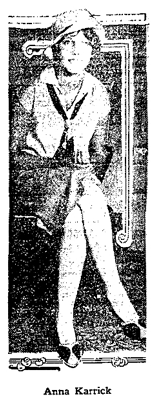 All the noir hallmarks here: a destitute, starry-eyed country girl, the shifty grifter she befriends, a rube with some dough in his pocket, a classic con, the crummy apartment hotel and a dark city.
All the noir hallmarks here: a destitute, starry-eyed country girl, the shifty grifter she befriends, a rube with some dough in his pocket, a classic con, the crummy apartment hotel and a dark city. place at
place at  532 South Fremont (now site of Glossy Black Tower, left) may be long gone, but it was a fun place while it lasted. In May 1929, Filipino nationals Cal Blanco and Ceferino Sandries argued over women with some sailors from the USS Colorado, when Blanco announced, “I’m going to kill all you sailors,” and so sailor Clyde Forehand shot them both dead; July of 1929 saw a riot there involving thirty sailors and six women, at which two women and seven men were booked on suspicion of robbery; Jack Wilson and Clark Falcon, leaders of a gang of automobile plunderers, were arrested with their booty here in February, 1932; in September 1935 Robert Honchell, a 25 year-old taxi driver, was having a drinking party with his pal Edward Folder, a 29 year-old unemployed café worker, when a woman showed up with her infant daughter—Folder’s insistence on taking the child out for candy started a quarrel, and Folder ended up stabbed mortally in the chest by Honchell…you get the idea.
532 South Fremont (now site of Glossy Black Tower, left) may be long gone, but it was a fun place while it lasted. In May 1929, Filipino nationals Cal Blanco and Ceferino Sandries argued over women with some sailors from the USS Colorado, when Blanco announced, “I’m going to kill all you sailors,” and so sailor Clyde Forehand shot them both dead; July of 1929 saw a riot there involving thirty sailors and six women, at which two women and seven men were booked on suspicion of robbery; Jack Wilson and Clark Falcon, leaders of a gang of automobile plunderers, were arrested with their booty here in February, 1932; in September 1935 Robert Honchell, a 25 year-old taxi driver, was having a drinking party with his pal Edward Folder, a 29 year-old unemployed café worker, when a woman showed up with her infant daughter—Folder’s insistence on taking the child out for candy started a quarrel, and Folder ended up stabbed mortally in the chest by Honchell…you get the idea.
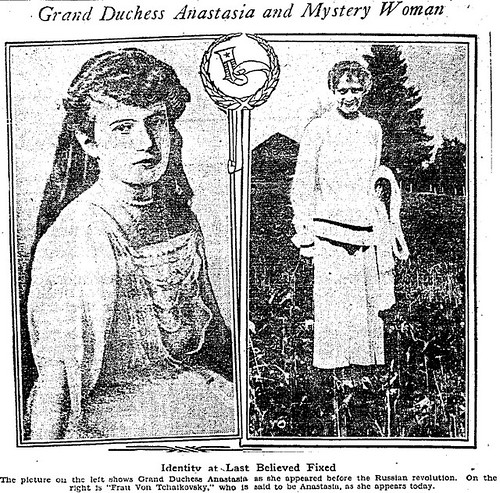


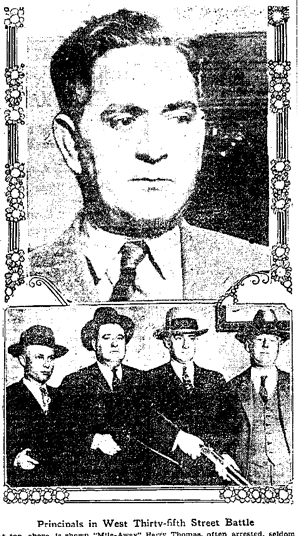 Officers responded to her call about a prowler, and when they arrived, acclaimed hijacker Thomas went for his piece. The cops opened up with a machine gun, a sawed-off shotgun and two large-caliber revolvers, and yet the twice-arrested-for-murder, “King of the Hi-Jackers” Mile-Away Thomas, filled with pounds of buckshot and slugs, ran from the garage straight at the cops.
Officers responded to her call about a prowler, and when they arrived, acclaimed hijacker Thomas went for his piece. The cops opened up with a machine gun, a sawed-off shotgun and two large-caliber revolvers, and yet the twice-arrested-for-murder, “King of the Hi-Jackers” Mile-Away Thomas, filled with pounds of buckshot and slugs, ran from the garage straight at the cops.